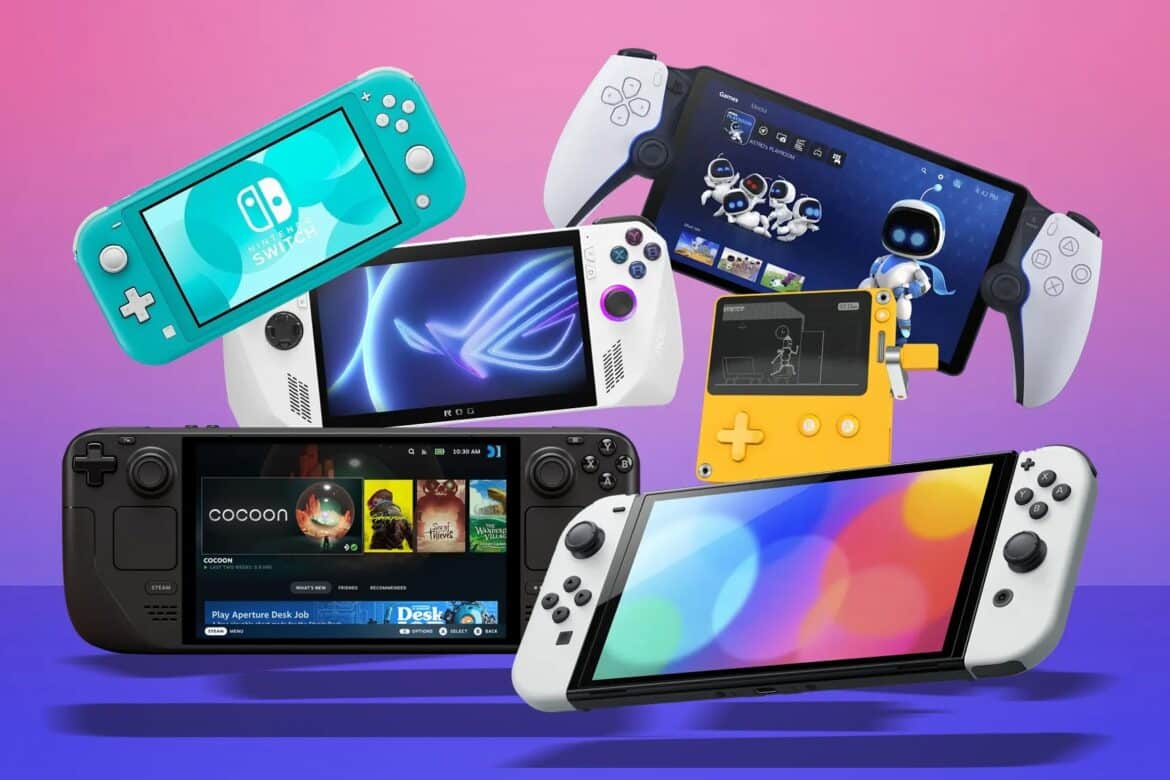270
You could fill an entire list with Nintendo consoles. The well-known brand is best known for its Playstation and games featuring the popular Super Mario.
An overview list of Nintendo consoles
Nintendo has been producing its own consoles since the 1980s.
- One of the best-selling consoles of its time is the Nintendo Entertainment System (NES), which could play 8-bit games and was first launched in 1983. With titles such as “Super Mario Bros.” and “The Legend of Zelda,” Nintendo laid the foundation for modern video game culture and shaped generations of gamers.
- The rise of portable classics: The well-known Game Boy followed in 1989. It combined the functions of a handheld device with the interchangeable cartridges of the Nintendo Entertainment System. With over 118 million units sold, it remains one of the most successful consoles of all time. The launch of “Tetris” made the Game Boy a global phenomenon and marked the beginning of mobile gaming.
- The Super Nintendo Entertainment System for 16-bit games followed in 1990. The SNES brought colorful graphics, stereo sound, and titles such as “Super Mario World,” “Donkey Kong Country,” and “Final Fantasy VI,” which are still considered milestones today.
- The Virtual Boy had a rather short run of only a few months in 1995. Here we can see the first beginnings of VR, which, however, were not very successful. Nevertheless, the Virtual Boy is considered a bold experiment that underscored Nintendo’s drive for innovation.
- The Nintendo 64 from 1996 was more successful. It got its name from its integrated 64-bit CPU. The transition to the 3D world with games such as “Super Mario 64” and “The Legend of Zelda: Ocarina of Time” set new standards in gameplay, camera work, and world design – to this day, it is considered one of the most influential consoles in history.
- The transition to the disc era: From 2001 to 2007, the Nintendo GameCube followed, which again did not bring any notable success. Despite mediocre sales figures, the GameCube was technically powerful and offered iconic games such as “Metroid Prime,” “Super Smash Bros. Melee,” and “The Legend of Zelda: The Wind Waker.” Its compact mini DVDs were a first step towards modern data storage media.
- In contrast, the Game Boy Advance enjoyed parallel success. It featured a color display and backward compatibility, and marked the peak of the 2D handheld era with titles such as Pokémon Ruby & Sapphire.
- Two screens and movement as a game principle: In 2004, the Nintendo DS was released. A handheld device with a touchscreen on the lower display and an LCD screen on the upper display. It became one of Nintendo’s biggest successes, with over 150 million units sold worldwide. Series such as “Professor Layton” and “Dr. Kawashima’s Brain Training” opened up new target groups beyond classic gamers.
- In 2006, the Nintendo Wii found its way into many living rooms. Here, the whole family could play together. With its innovative motion controls, it changed the way people perceive video games. “Wii Sports” became one of the best-selling games in the world and even turned retirement homes into tournament arenas.
- In 2011, the Nintendo 3DS with 3D functionality was released. It perfected portable gaming with improved graphics and StreetPass features before smartphones conquered the market.
- In 2012, the Nintendo Wii U was released, which was mainly controlled by a GamePad. Although it was not a commercial success, the Wii U paved the way for the Switch with its second screen concept.
- In 2016 and 2017, Nintendo released the NES Classic Mini and Super NES Classic Edition retro consoles with 30 and 21 pre-installed games, respectively. These devices struck a chord of nostalgia and demonstrated the timeless popularity of classic Nintendo titles.
- The Nintendo Switch era: The Nintendo Switch has been on the market since 2017 and was long considered the only true handheld of its time. The Lite version followed in 2019, and an OLED model with improved graphics has been available since 2021. The hybrid console combines stationary and mobile gaming in one device—a revolution that brought Nintendo back to the top of the market. With games such as The Legend of Zelda: Breath of the Wild, Super Mario Odyssey, and Animal Crossing: New Horizons, the Switch set new creative and economic standards.
- In 2024, the Nintendo Switch 2 was officially unveiled, with improved processing power, DLSS support, and magnetic Joy-Cons. This generation builds on the success of the first Switch and demonstrates Nintendo’s ability to combine innovation with tradition.
The most famous game titles from Nintendo
But what would all these consoles be without the famous Nintendo titles? Here is a list of popular games for the different consoles:
- Super Mario 64 – revolutionized 3D platform games and shaped modern game design.
- The Legend of Zelda: Ocarina of Time – considered one of the best games of all time and set new standards in storytelling and exploration.
- New Super Mario Bros. 2 – proved the timeless appeal of classic 2D platformers.
- Pokémon Red & Blue – established a global franchise and connected multiplayer gaming via link cables for the first time.
- Final Fantasy VI – demonstrated the emotional depth of 16-bit role-playing games.
- Super Mario Kart – laid the foundation for the popular multiplayer racing genre.
- Dr. Kawashima’s Brain Training – opened up new target groups and combined entertainment with mental training.
- Wii Sports – turned movement into gameplay and reached people of all ages.
- Animal Crossing: New Horizons – became a cultural phenomenon of togetherness and simply a “digital refuge” during the pandemic.
- Nintendo thus stands not only for technology and gaming fun, but also for emotion, nostalgia, and community—a legacy that continues across generations.

